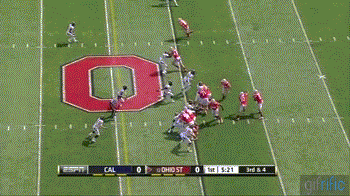Good "layman's description" of what a torn labrum (Bracton's injury) is on 11W:
THE PATHOPHYSIOLOGY BEHIND BRAXTON MILLER’S TORN LABRUM
While we watch and wait for Braxton's return, I’ll review the details of a torn labrum to help make sense of the shoulder Ohio State fans are all rooting for.
First, I’ll quickly discuss the shoulder joint using a golf analogy to help in visualizing the anatomy. There’s a ball, which is the very top of your arm bone (humerus), and a socket, which is much like a golf tee made by the shoulder blade (scapula) to hold the ball. The socket (“tee”) created by our scapula is rather shallow. That is, the “ball” could easily fall away from it without additional support. That’s where the labrum comes in to play.
The labrum of the shoulder is a ring of cartilage that is designed to hold the ball in place. It makes the socket deeper. Imagine this like a golf tee that comes up and wraps a bit around the ball. The labrum makes it much more difficult to dislocate the shoulder. It provides stability while still allowing the joint to have the range of motion necessary for throwing 40-yard touchdown passes to Devin Smith (just one emotionally-charged example).

When the labrum tears, the shoulder joint loses its aforementioned stability. Further, the torn piece of cartilage hanging around can interfere with the normal, fluid motion of the shoulder, causing pain, clicking, grinding, and/or popping. Imagine the deep golf tee again, but this time with part of the plastic rim clipped and frayed. It would be impossible to smoothly spin and move the ball around inside its tee without the plastic piece getting in the way. Other symptoms of a torn labrum can include weakness and decreased range of motion. All of these issues, of course, would hinder a throwing athlete. Tears can occur from direct trauma, chronic overuse, or single-event stresses.
Torn labral cartilage does not heal like a torn hamstring. The labrum has a relatively poor blood supply. Healing factors in our blood are delivered to sites of injury, but when blood supply to an area is scarce, healing becomes delayed and stagnant. Enter the orthopedist. Surgical intervention is often necessary to repair a torn labrum, and re-injury, as we unfortunately know, is possible.
The recovery time of a labral repair is cited to be anywhere from 6-12 months before the patient returns to “normal function.” When considering timelines, it’s important to keep in mind that an athlete’s “return to normal” is much different than that of a non-athlete.
.
.
.
continued
Entire article:
http://www.elevenwarriors.com/ohio-...eed-to-know-about-braxton-millers-torn-labrum





